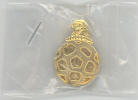
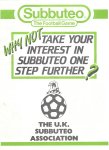
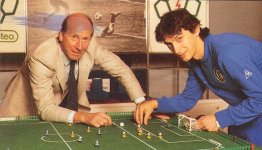
| Peter Upton's |
Subbuteo Tribute Website. |
|
The History of Competitive Table Soccer |
If you've arrived on this page from Part Two of this history, then you will know how manufacturers, Subbuteo Sports Games Limited, and the amateur players of The English Table Soccer Association fell out over differences in aims, rules and equipment. Subbuteo had offered to take over the running of the European Table Soccer Federation, but the players did not relish this company control. However, this set back did not change SSG's strategy. They simply used the assigned marketing budget to set up their own equivalent organisation.
The Subbuteo Club 1976-78
The United Kingdom Subbuteo Association 1979-93



The Subbuteo club was first advertised in the 1977 Subbuteo catalogue (so launched for the 1976-77 football season). Clearly aimed at Subbuteo's youth market, the club offered the usual tempting goodies of a badge, membership card and newsletters. George Underwood, former secretary of the TSPA and still at the company, returned as secretary of the new association, which linked the two associations together rather nicely. Showing the advantage of professional marketing, Bill Shankly became the Subbuteo Club President. A player who won his local league would be sent a signed certificate from the great man. After Bill Shankly sadly passed away, Bobby Charlton was appointed in his place.
The Club took a little time to find its feet. After a couple of years it was renamed to the more serious sounding United Kingdon Subbuteo Association. There were affiliated clubs in Scotland (SSA) and Wales (WSA). Later still, the UKSA became part of the Federation of International Subbuteo Associations (FISA). Bobby Charlton was made Hon President of this world body, and also Patron of the UKSA (that's a lot of acronyms for one paragraph. I hope you are taking notes).
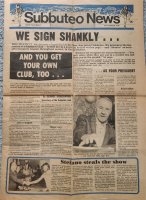
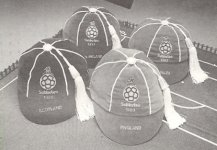
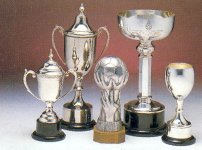
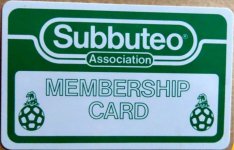
The Club newsletter was originally called (rather boringly) the Subbuteo News. The first issue (shown here) was dated September 1976, and was a simple four page black and white newspaper style publication with just a splash of blue. It was more professionally produced than the ETSA newsletters of the 1970s of course, but with much less detail. The first edition is understandably sparse, with the headlines explaining about the club, and the arrival of Bill Shankly as club president. The main news was about the championships in Italy. Inside was a chance to win one of the new Subbuteo grandstands. Bill Shankly does write a short article for most of the early issues.
Subbuteo News had a fairly erratic publishing schedule, with the first five issues being dated September 1976; February 77 (headline was Mike Dent winning the Europa Cup in Malta); October 77; January 78; and November 78. The newsletter was renamed The Subbuteo Falcon with issue six which arrived over a year after issue five in December 1979. Later issues return to being called Subbuteo News, and I've seen these with issue numbers in the 20s.
The 1979 catalogue mentioned joining for the chance to compete in Home Internationals, and the World Cup. A European Cup was later added to the roster, again tying in with the real football event. Professional looking caps were awarded to those playing in Subbuteo internationals, and an array of fine silverware was displayed in the catalogues. As joining the club was simply a matter of sending a cheque, membership grew at a pace. As early as January 1978 the ETSA are remarking that there are "over 100 leagues in Subbuteo's junior club". Okay, so most were probably just a few mates in someone's bedroom, but it was certainly what SSG had in mind.
The UKSA could use its marketing clout and connections to provide attractive competition for its members. Tournaments could be staged in some of the bigger stockists, and Worthing Five-Star Club founder Brian Barnes remembers playing a competition "in the window of Hamleys", and he also played in the toy department at Harrods. Bigger tournaments were held at holiday camps like Butlins. Participants in tournaments were often given lightweight teams as reward for attending. These were usually unsold/unpopular stock, which might have been disappointing at the time, but probably look a lot better now, with prices of rare teams increasing impressively in the 2000s.
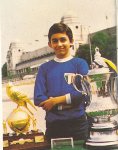
The 1978 World Cup was held at the Wembley Conference Centre, and bought sixteen-year-old Italian Andrea Piccaluga to the fore. He beat the 1974 champion (Dirk Baerwald) in the final. The young Italian was just the kind of player Subbuteo needed. John Burbidge took him on a successful tour of England and Scotland, and the 1980 catalogue describes him as an "ambassador for his country and for his sport".
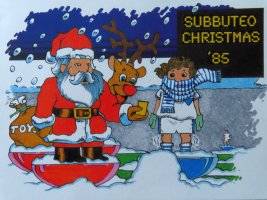
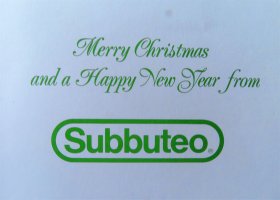
This cute little Christmas card was sent in to the website by old UKSA member Stephen Corry. Pleasingly it is dated, so we know Subbuteo sent it out in 1985. A nice little extra for association members.
The 1980s - Lightweights and polish.
If 1978 announced the arrival of the Italians in international competition, it was with a proviso. This was Subbuteo's version of the game, played with OO scale figures. Although players could (and did) use OO scale figures at ETF events, The Europa Cup was still dominated by the old guard playing with the 1950s flat figures.
However, in what was a delicious irony, the Italians found a way to improve their "clumsy" OO-scale figures. They simply used a basic household polish to cut down on the friction. Suddenly, the figures could slide the length of the pitch and previously tricky long range flicking became easier. It also meant they slowed up more gently, allowing for better control. In addition, they experimented with the weight of the base to add power to their shooting.
The Italians dominated the 1982 World Cup with these new techniques, but it was a Swiss player, Willy Hofmann, who perfected this method of play and took it successfully to the Europa Cup. Just a few months after the 1982 World Cup, Hofmann used his polished OO scale figures to win the Europa Cup in his home country of Switzerland. He went on to dominate the 1980s table soccer scene, retaining the Europa Cup in 1983 and 1984, and then winning it again in 1987, 1988 and 1990. In between he won the 1986 Subbuteo World Cup.
Suddenly flat players were not a better way of playing, but simply a different way of playing. The main reason for having two separate associations was gone. In some countries (and Willy Hofmann's Switzerland was one) there was only ever one association anyway, playing in both sets of competition. It made sense to try and bring everyone back together.
The 1990s - New Associations and new ideas.
The 1990s started well for Subbuteo's FISA with the 1990 World Cup, which featured on Channel Four in the UK. However, the game's popularity was declining amongst youngsters, and Waddingtons were finding the administration of Subbuteo tournaments around the world to be a burden. Proposals for a player run association were put forward at the World Cup, and this new independent Federation was launched in 1992. (I suspect it took two years to find an acronym that table soccer had yet to use....). The new organisation was called FISTF. Originally, this catch-all name stood for The Federation of International Subbuteo Table Football. However, the dislike of the word "Subbuteo" lingered, and it was said that this implied company control. It did not help that the representative of the old English Subbuteo Association (ESA) who had remained on the board was also a SSG employee. So in 1994 the word Subbuteo was removed, and replaced with the word Sport. This was frankly a bit rubbish, but I suppose it was agreed that this was better than having to change all the logos once again.
The English Subbuteo Association was still a strong organisation coming into the early 1990s, with a new quarterly newsletter called "Subbuteo Scene". Issue 8 of the Scene (October 1992), was positive about the outlook. The Editorial mentions the new world organisation, player classifications, more organised events, and the regular newsletter as positives for the sport. The attendance at tournaments seems to back this up. They were clearly proud of The Shoot Junior Grand Prix, which was held at the National Football Show at Earls Court, featured forty junior players, and had prize giving by former West Ham Utd star Tony Gale. Their Open tournaments were split into three categories (junior, youth and senior). Their summer opens included Bristol (40 entries); Micklesfield (55); Middlesex (26); Cheshire (34); Lancashire (31); Yorkshire (50); Tameside (28) and Hemel Hempstead (an impressive 84 entries). The UK classification table showed the top 30 players in each category, and the total number of different players at their tournaments that year was 303. This was a nice mix of Juniors (107), youth (72) and senior (124), although the genders were much less of a mix with only five female players.
The ESA was still linked to Subbuteo in 1992, and The Scene featured an order form for Subbuteo items ordered direct (with a 10% discount) and a range of club offers. There was a page of T-shirts advertised from "Arkwright" Sportswear, featuring some classic Subbuteo images (and pre-dating the current trend for retro Subbuteo wear by about a decade). There were also limited edition souvenirs from the 1992 European Championship, such as badges, key rings and pens etc.
However, things do not look so rosy a year later. The Autumn 1993 issue of The Subbuteo Scene (issue 12) stressed the lack of funds. "The ESA is now fully financially independent from Waddingtons, and there is not that much to play with". In addition, they were waiting to hear from the ETSA as to whether their members wanted to merge the Associations together. A new board had been elected to run the ESA, although "sadly only two persons formally applied", and the membership are ticked off for "failing to support the progress of the ESA". The board would only be temporary if the merger took place. The ESA were also having to deal with the new FISTF rules, which they were not going to adopt until the end of the current season (so not until 1994). As we saw on the previous page of this history, the ETSA had experience in coping with rulebooks from Europe, and with an apathetic membership. So the merger was hopefully a good match...
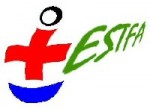
The coming together of associations finally resulted in the formation of the current English governing body - The (deep breath) English Sport Table Football Association (ESTFA).
Incidentally, the Autumn 1993 edition of The Subbuteo Scene also mentioned that the first Subbuteo Collectors Club was now up and running. So perhaps there was a reason for me to have joined all those years ago (damn).
On and into the future.....
With the old animosity a thing of the past, and the word Subbuteo having a lot of joyful retro-credibility in the 21st Century, the above association has decided to revert back to being simply the English Subbuteo Association once more. It certainly makes sense, as everybody in the UK calls the game Subbuteo automatically anyway. It ties in with the memories of old players returning to the game, and with the new products being released in the junior market.
The aim is to make this long established national association the central point for all Subbuteo and table soccer activity in the country. The noble aim is to bring everyone who loves the game together whether they play modern rules with sliding players, or old school rules with heavyweights or flats - or anything in between. As we are a minority hobby, this needs to include the collectors as well.
This website's technology sponsor, Alan Lee, is keeping the site updated with news of clubs and events. With lockdown easing, there are a number of new clubs and events being arranged. The English Subbuteo Assn website is the place to see if there is anything happening close to you. I would strongly recommend this. I am not the most outgoing of people, but I've always found the table soccer community to be very welcoming. There are players of all abilities, so don't let a fear of being outclassed put you off....
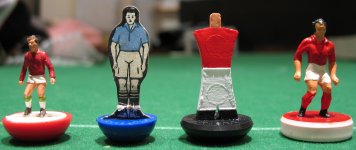
A wide choice of figures.
Bringing everybody together brings another bonus. The ETF rules had always allowed players to use any equipment as long as it fitted a qualifying criteria, which was mostly to do with the size and shape of figures and bases. So bases had to be within a certain size limit, and there had to be a footballer figure on top with a body and a head. These rules allowed for experimentation, and with their adoption across the whole sport, a market opened up for improved bases and figures to be produced. Obviously this market was too small for Waddingtons to bother with, so it was left to others to produce new items. These were initially done on a very small scale basis, and with manual, time intensive production, so the new bases were initially very expensive - often £30-£50 a set, when a standard Subbuteo team cost about £4. However, top players found the improved performance to be irresistible, and the market has continued to grow.
I'll finish my review of tournament Table Soccer, with a look at some of the figures and bases produced since 1990.
Sport Figures.
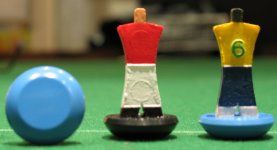
I believe that these were the first new figures bought to the market, arriving in 1992. They were a radical redesign, and importantly did not infringe on any Subbuteo patents that might still be force. Willy Hofmann helped in the design of the figures, so they had good pedigree. The players are very stylistic, and made from polystyrene, making them very light. This made the centre of gravity much lower than usual, and so their balance is very good. The base has the large flat bottom essential for the modern sliding game, but there is still the ability to spin these players with practise. It is also worth noting (on all the bases on this page) that the top edge of the base is bevelled, to make the chip shot easier.

A similar figure was the "woodentop", a balsa wood figure made by Tom Taylor in the UK and sold from his table soccer shop. This was a useful replacement figure because the polystyrene figures are understandably fragile.
Toccer Figures.
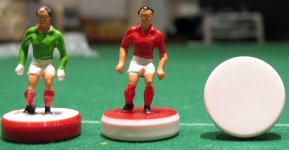
These figures were first produced in 1994, but seem to have disappeared from the game in recent years. As you can see on the picture at the top of this section, these playing figures are very large, and the bases have no curve to them at all. It is basically a player mounted on a draught (or a disk from Otello). What you cannot see from the picture is the weight of these figures, which is very heavy. If your tactic is to force holes in your opponents defence with an attacking figure (after touching the ball first of course) you will find it hard against these giants.* Likewise, it is hard to force throw-ins off the figures. On the downside, this figure is not very subtle in play, and the totally flat base is restrictive. It was generally regarded as a good figure for beginners.
*Not a great tactic in the 2020s, as a "smashing" rule has been introduced to cut down on this.
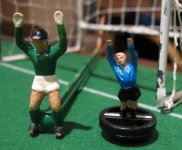
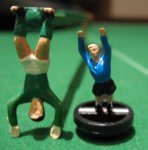
The one lasting change that Toccer was responsible for was the table soccer goalkeeper. At first glance, the Toccer goalkeeper looks huge, and you wonder how it can be within legal limits. However, if you stand him on his hands, you will see how the size rules have been used. The width of the hands is simply the width of the base of a Subbuteo figure (the Toccer keeper has no wide base) The thinner legs on the Toccer correspond to the body on the older style man, whilst the extra height simply matches that of the old flat goalkeeper. Nevertheless, Toccer 'keepers are obviously chunkier than the alternatives, and use of them has become widespread. Originally, you had to play with a goalkeeper that matched your team (i.e. flat keeper with flats) but the rule was quietly dropped under much abuse of the system.
The deluxe Italian brands.
Astrobase, Biemme and Profibase.
|
|
|
|
An early profibase |
Tri-colour Astrobase. |
These Italian manufacturers produce high quality bases that are relatively expensive. They are all designed to use the simple lightweight pegged figure as sold by Subbuteo, and as used (more often than not) by Italian players. There are differences between manufacturers of course, but I'm not an expert so I've included them as a single entry.
The bases come in a variety of different sizes, and are coded depending on the profile used. There are three different measurements to consider. The height of the base, the width of the bottom of the base, and the width of the top of the base. Obviously, the sizes have to conform to FISTF regulations, so in practise the differences are pretty small, with perhaps just the bottom width changing by more than a millimetre. If an opponent tells you he is using "C5" bases, then this tells you what dimensions his bases have (it also tells you to make your excuses, and find an easier opponent).
There are one-piece bases, and two-piece bases (allowing the weight to be altered), and a wide variety of colours. The tri-colour Astrobases are especially nice, and transparent bases are a novelty.
Both Astrobase and Profibase have recently dipped their toe into mass-market products. Astrobase designed the bases for Parodi's licensed Subbuteo in the early 2000s, and these bases are now found on its Soccer 3D range. Profibase are currently supplying bases for Parodi's Zeugo teams.
Lunula PTF Sureshot and Advantage.
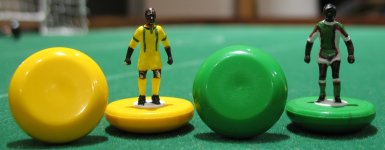
These bases remain a popular budget choice for tournament players. Introduced in the late 1990s, they are a mass-produced two-part base for pegged figures. Weights were not supplied, but that meant you could find your own preferred washer size. The sureshot is a very low profile base with a wide bottom, and very little opportunity for curling (although I've seen it done - you just need smaller fingers than me!) The Advantage gives you slightly more curve, so it has slightly less width at the bottom and it is fractionally higher. In the above photos, the Sureshot is the yellow base, and the Advantage is the green base.
Wycombe Table Football club are now the main distributor of PTF Sureshot and Advantage Professional Bases. They also sell a wide range of painted teams to get you up and running as quickly as possible.
Alan Lee of the Wobbly Hobby Shop has a good range of original Sureshot bases acquired when the Woodentop shop closed down. Supplied with the new figures, they are a great starter base.
Stefan Corda - Raptors.
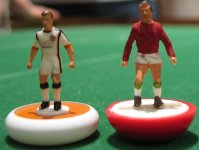
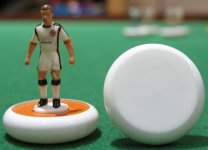
A British manufacturer of figures and bases, Stefan Corda produce two distinct bases, and a range of pegged figures to go in them. The Raptor is their tournament base for the modern style of play. This has a different design than the bases mentioned above. As normal this has a large flat bottom, but the top edge slopes in towards the player. This makes chipping much easier. In addition, the two piece base has a large section available for a weight. A heavy raptor packs a powerful shot. The original raptors sacrificed some of the gentle touch of other bases, but subsequent production has improved this.
Their other base is the Image. This is a "retro" base designed to be able to curl like an old heavyweight. It is much higher than other modern bases so chipping needs practice. They have been used for retro tournaments in the UK.
As mentioned, Stefan Corda also make figures to go into pegged bases. The 2K4 figure can be seen in these pictures, and in the yellow Advantage base in the previous section.
August 2020: Since I wrote this page, a couple of extra manufacturers have appeared among the Worthing Five-Star equipment. As we are currently unable to meet up due to the Covid lockdown, I can't take pictures of the teams in use at the club (which I prefer). However, here are the new bases as photographed by their makers....
Little Plastic Men - the iBase, and CLR Dynamic.
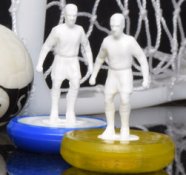
Another British manufacturer, Mike Peacock has developed these two bases, which have a unique "shock absorber" insert, to try and get that perfect "soft touch" ball control. In Mike's picture above, the yellow base is an iBase, and the blue base is the CLR Dynamic. These bases are in the more reasonable price range of the Sureshots and the Raptors, rather than the expensive Italian fare.
Tchaaa4 -Bases and Figures.
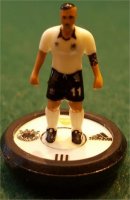
This newer range, from Belgian player Daniel Scheen, is rapidly gaining traction at the Worthing Five-Star club, and in the wider table soccer community. The bases are very recognisable in play, because the inner is set lower than the rim of the outer base, which doesn't happen on any of the other bases. The range has various differently named bases for different styles of play - so there is the "snake" base for curling, the "bee" that seems to be a mixture, and the flatter Arrow and Sniper bases. Top of the range (certainly price-wise) seems to be the Arrow 2.0 base. Unlike the LPM bases above, these are another deluxe base, with a higher price point.
In addition to his bases, the range is complimented by a new playing figure, which is designed to be perfectly balanced - "front to back, and left to right". The players are available in a wide range of coloured plastics. Again, UK buyers are directed to the Wobbly Hobby Shop.
Other Manufacturers.
As Subbuteo availability varies from country to country these days, this has encouraged fans in other countries to produce their own equipment. Among these new manufacturers are Flickmaster in Argentina, and Speedy Bases in Greece.
Other Equipment.
When the ETSA first split from SSG in the late 1970s, one of their aims was to make a total split from Subbuteo by manufacturing all their own equipment for the game. Sadly, a lack of resources meant that this was never really possible, but the rise of other table table soccer manufacturers has meant that this goal (sorry) has now been obtained. It is actually quite likely that no Subbuteo made equipment will be seen at a modern table soccer event. Like football, a basic table soccer game needs a pitch, a couple of goals, and a ball.
Pitches started to be manufactured independently when Hasbro stopped production of the popular Astropitch around 1996. Most English clubs have at least one pitch from Tom Taylor's Woodentop range who produce pitches in a range of sizes. The Woodentop Prima is the standard size of Subbuteo pitch (4'6" by 3'). The Liga is a shorter version, whilst the Mawra is the standard length, but wider. Many of the other manufacturers mentioned above also produce their own pitches. Most new pitches have sticky backs, ready to be permanently fixed to a wooden base. The Extreme Works pitches seem to be the current go-to choice for tournament/club play.
Goal production is also widespread. What most of these goals have in common is that they are constructed of metal, and that they are designed to screw through the pitch and playing board, making a robust goal you don't have to hold with your hand.
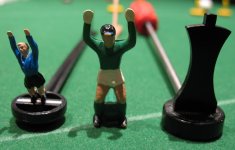
The large Toccer goalkeepers also started a revolution in goalkeeper design. The Toccer keeper has been reproduced in metal, and various other goalkeepers within the agreed standards have been manufactured. (but all seemingly adding the odd millimetre here and there).
So that brings us up-to-date with the table soccer scene, but before you trip off to another site, lets have a quick test to make sure you have been paying attention.
Explain the following acronyms.
* Okay, so sadly there was never a World Table-Soccer Federation.
All that is left for me to do is credit the member's of the Worthing Five Star Table Soccer Club for their help with this part of the website. So thanks to Brian Barnes, Brandon Lavender, and Ian Maskell, who let me photograph their equipment (no, not like that), and especially big thanks to Dave Croucher, for information and loan of ETSA materials. For the record, Brian plays with the Profibases, Brandon owns the raptors, the Sureshot/Advantage sides are mine (although Dave uses these bases with far more skill than me), and the Toccers, Sports and Astrobase figures are Ian's (he's an Astrobase user more often than not).